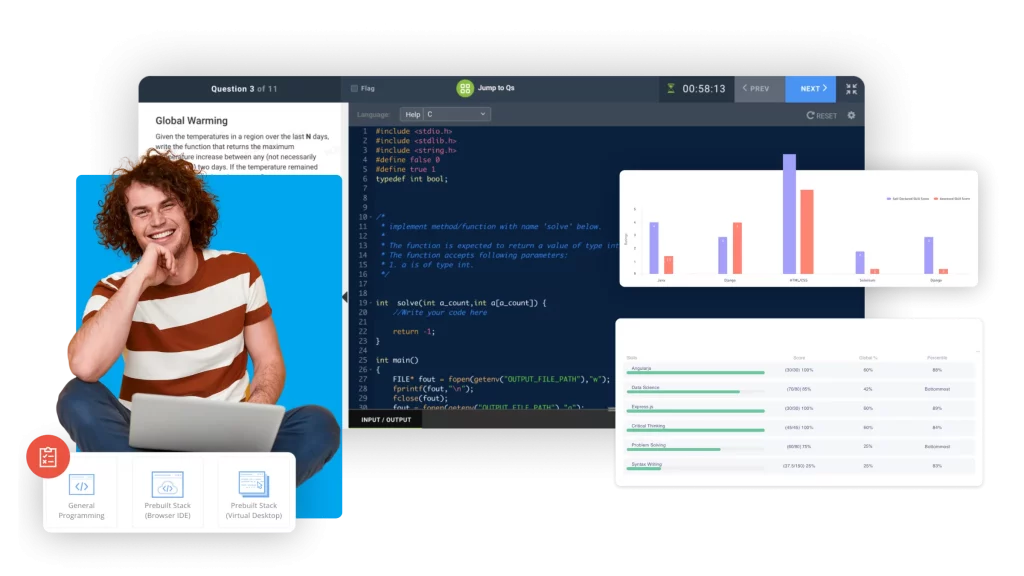
Make talent quality your leading analytic with skills-based hiring solution.

Conducting a thorough technical evaluation is crucial for hiring the best talent in the technology sector. Technical evaluations help to ensure that candidates possess the necessary skills and expertise to excel in their roles. With the rapid advancement of technology, traditional interview methods are no longer sufficient. Utilizing AI and automated tools can significantly enhance the accuracy and efficiency of technical assessments, ensuring that you hire the most qualified candidates. This guide provides a comprehensive approach to conducting technical evaluations, emphasizing the role of AI in the process.

A technical evaluation is a detailed assessment of a candidate’s technical skills and abilities. It typically includes coding tests, technical interviews, and practical tasks that simulate real-world job scenarios. The primary objective is to verify the candidate’s proficiency in specific programming languages, tools, and technologies relevant to the job.
Skills Verification:
Real-World Readiness:
Objective Assessment:
Efficient Screening:
Before you begin the evaluation process, clearly define the technical requirements of the job. Identify the key skills, programming languages, and technologies that are essential for the role. This will help in creating or selecting appropriate assessment tools and tasks.
Selecting the right tools and platforms is critical for an effective technical evaluation. Look for solutions that offer:
Assessments Library:
Customization:
Automation:
Standardization:
Diversity and Inclusion:
Develop clear criteria for evaluating candidates’ performance. This should include:
Skill Proficiency:
Problem-Solving:
Coding Best Practices:
Real-World Application:
Based on the job requirements and evaluation criteria, create or select assessments that accurately measure the required skills. Ensure that the assessments are challenging yet relevant to the role. Types of assessments can include:
Coding Tests:
Technical Interviews:
Practical Tasks:
Administer the assessments using your chosen platform. Ensure a seamless and user-friendly experience for candidates by providing clear instructions and support. Key features to leverage include:
AI Proctoring:
Real-Time Feedback:
Once the assessments are completed, evaluate the results using a combination of automated scoring and review. AI can play a significant role here by:
Automated Scoring:
Intelligence:
Verification:
Share the results with relevant stakeholders using detailed reports and recordings of assessment sessions. This facilitates collaboration and informed decision-making. Key reporting features include:
Interview Summaries:
Performance Reports:
Candidate Reports:
Offer constructive feedback to all candidates, regardless of the outcome. This not only helps candidates improve for future opportunities but also leaves a positive impression of your company.
AI-powered tools can significantly enhance the technical evaluation process by providing several key benefits:
AI-Generated Questions:
AI Evaluation:
AI Guidance:
Skill Matching:
Recordings:
ATS Integrations:
Here are some common tasks and tests that can be included in a technical evaluation:
Coding Challenges:
Algorithmic Problems:
System Design:
Debugging Exercises:
Code Review:
To ensure a fair and effective technical evaluation process, follow these best practices:
Maintain Consistency:
Ensure Fairness:
Take Detailed Notes:
Communicate Clearly:
Provide Constructive Feedback:
A technical evaluation is essential for hiring the best technical talent. With a structured approach and making use of AI-powered tools, organizations can streamline the process, reduce biases, and ensure that they hire candidates who are not only technically proficient but also a great fit for your organization. The right combination of technology and best practices will help companies build a strong and capable technical team ready to tackle the challenges of today’s dynamic tech landscape.

Why Total Talent Management Fails Without a Skills First Strategy When you consider all the disruptive forces reshaping work—from AI in recruiting to the impact of tariffs on the global economy—bold thinking isn’t optional. It’s essential. And, Allen Chilson is the Contingent Workforce trailblazer helping Danaher Corporation navigate that uncertainty. Serving as the Director of […]

AI-Powered Total Talent Management for Contingent Worker Success With over a decade of experience managing global contingent worker programs, Natalie Javid brings a wealth of knowledge from her work at tech giants like ServiceNow, Airbnb, and her current role as Head of Global Contingent Workforce at Snowflake. Speaking at ProcureCon 2025, Natalie shared insights on […]

Revolutionizing Future Trends with AI in Contingent Workforce Management The Human Touch in an AI-Driven Industry Eric Osterhout brings almost two decades of experience to the contingent workforce management space, currently serving as a Program Leader and Buyer for Contingent Labour at Huntsman Corp. With 17 years on the buyer side and 10 years previously […]